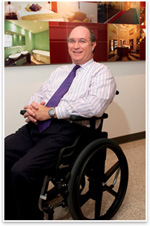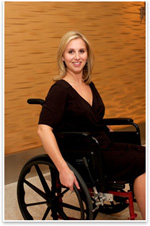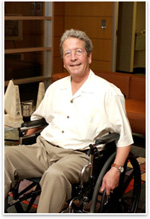Best Practices
Accessibility Awareness Exercise Gives Architects a New Perspective
by Russell Boniface
Associate Editor
Summary: AIA Dallas’ accessibility awareness exercise last fall, held at its chapter office, gave 14 members the opportunity to spend a day in a wheelchair. The exercise, which included embarking to lunch while seated, gave them a different look at accessibility, both literally and figuratively. The participants discovered firsthand the challenges of wheelchair accessibility at and around an office while gleaning ideas for making spaces more accessible.
 The day-long program, spun from the chapter’s Legacy Committee and in its second year, was an awareness-building exercise, says Walter Kilroy, AIA, chair of the AIA Dallas Legacy Committee. “Our goal wasn’t to verify the requirements we all know, but rather to discover what small adjustments in our designs might make a big difference in accessibility. We weren’t trying to prove or disprove ADA or Texas accessibility, or make light of people in wheelchairs.” The day-long program, spun from the chapter’s Legacy Committee and in its second year, was an awareness-building exercise, says Walter Kilroy, AIA, chair of the AIA Dallas Legacy Committee. “Our goal wasn’t to verify the requirements we all know, but rather to discover what small adjustments in our designs might make a big difference in accessibility. We weren’t trying to prove or disprove ADA or Texas accessibility, or make light of people in wheelchairs.”
The participants discovered that tasks are very challenging in a wheelchair, including:
- Reaching for a printout
- Moving from computer to phone/files
- Going through glass doors
- Navigating a cross slope
- Circulating among cubicles
- Maneuvering on carpeting
- Pushing an elevator button
- Getting coffee
- Going to lunch.
 “We gained insight into our own accessibility designs from a seated perspective,” says Kilroy. “We learned many things, including how much extra time it takes to access the accessibility accommodations we place in the built environment.” “We gained insight into our own accessibility designs from a seated perspective,” says Kilroy. “We learned many things, including how much extra time it takes to access the accessibility accommodations we place in the built environment.”
Being in a wheelchair is hard work
Robert B. Dupree, AIA, partner, Gromatsky Dupree & Associates, sought to get an understanding of the challenges facing his 14-year-old son, who has Duchenne Muscular Dystrophy. “I hoped to get a better understanding of the challenges he will face as this disease slowly robs him of his strength. I also wanted to try to get a better understanding of the emotions he will experience as he has to spend more time in a wheelchair,” he says. “I learned it’s hard work. My arms were sore for three days after the event. Soft floor surfaces, such as thick pile carpeting, cause you to work harder. Quarter-inch bumps in floors cause difficulty. Doors become obstacles. A six-inch curb ramp transition isn’t easy to traverse, and there’s a good reason behind the requirement for intermediate landings in long ramps.”
 C. Mark Seiley, AIA, principal, Leo A Daly, points out that it’s
awkward working at a desk while in a wheelchair. “The wheelchair
doesn’t move like a desk chair. Getting from computer to phone
to desk to files becomes a chore and takes many movements. You need
to use both hands rather than just using your feet.” He found
himself searching for the easiest way to get to locations, i.e., “routes
that were the widest, without any obstacles on the floor or walls.” He
found it difficult to move on thick carpet. “You build up static
electricity and get shocked.” C. Mark Seiley, AIA, principal, Leo A Daly, points out that it’s
awkward working at a desk while in a wheelchair. “The wheelchair
doesn’t move like a desk chair. Getting from computer to phone
to desk to files becomes a chore and takes many movements. You need
to use both hands rather than just using your feet.” He found
himself searching for the easiest way to get to locations, i.e., “routes
that were the widest, without any obstacles on the floor or walls.” He
found it difficult to move on thick carpet. “You build up static
electricity and get shocked.”
Emily Hoffman, client development manager, BOKA Powell, allowed herself plenty of time to get to destinations while also experiencing limited reach. “I was unable to reach our coffee makers, cream, and sugar, so I had to count on coworkers to help me. I was unable to reach anything off the printer, so I had to ask for help.” Hoffman explains that going in and out of big glass doors was close to impossible. “By the end of the day, my hands were numb and raw,” she adds.
 Part of the exercise was getting to lunch. During lunch, Dr. Richard Scotch, a sociology professor at University of Texas at Dallas, spoke to members about how people react to the accessible spaces architects design, as well as seeing the world from a lower plane of vision. David Collins, AIA, principal, Perkins + Will, discovered the challenge of going to a deli across the street for a mid-afternoon snack. “The journey, which can be done in about 10 minutes by foot, took over 45 minutes. The parking lots and streets were difficult to maneuver. I wasn’t prepared to find a way to carry the snack. Placing it in my lap worked okay, but I did find myself having to stop to reposition it.” Part of the exercise was getting to lunch. During lunch, Dr. Richard Scotch, a sociology professor at University of Texas at Dallas, spoke to members about how people react to the accessible spaces architects design, as well as seeing the world from a lower plane of vision. David Collins, AIA, principal, Perkins + Will, discovered the challenge of going to a deli across the street for a mid-afternoon snack. “The journey, which can be done in about 10 minutes by foot, took over 45 minutes. The parking lots and streets were difficult to maneuver. I wasn’t prepared to find a way to carry the snack. Placing it in my lap worked okay, but I did find myself having to stop to reposition it.”
A nationwide AIA event
Kilroy believes the exercise will encourage architects to make the built environment more accessible. He hopes it could become a national AIA event. “I would like every chapter to do this on the same day. I think if it were adopted nationally, it would be a great public relations opportunity and enlighten everyone who goes through it,” he says. “Accessibility isn’t just checking off boxes on an accessibility checklist. It’s exactly what the word says.”
|


 The day-long program, spun from the chapter’s Legacy Committee and in its second year, was an awareness-building exercise, says Walter Kilroy, AIA, chair of the AIA Dallas Legacy Committee. “Our goal wasn’t to verify the requirements we all know, but rather to discover what small adjustments in our designs might make a big difference in accessibility. We weren’t trying to prove or disprove ADA or Texas accessibility, or make light of people in wheelchairs.”
The day-long program, spun from the chapter’s Legacy Committee and in its second year, was an awareness-building exercise, says Walter Kilroy, AIA, chair of the AIA Dallas Legacy Committee. “Our goal wasn’t to verify the requirements we all know, but rather to discover what small adjustments in our designs might make a big difference in accessibility. We weren’t trying to prove or disprove ADA or Texas accessibility, or make light of people in wheelchairs.”
 C. Mark Seiley, AIA, principal, Leo A Daly, points out that it’s
awkward working at a desk while in a wheelchair. “The wheelchair
doesn’t move like a desk chair. Getting from computer to phone
to desk to files becomes a chore and takes many movements. You need
to use both hands rather than just using your feet.” He found
himself searching for the easiest way to get to locations, i.e., “routes
that were the widest, without any obstacles on the floor or walls.” He
found it difficult to move on thick carpet. “You build up static
electricity and get shocked.”
C. Mark Seiley, AIA, principal, Leo A Daly, points out that it’s
awkward working at a desk while in a wheelchair. “The wheelchair
doesn’t move like a desk chair. Getting from computer to phone
to desk to files becomes a chore and takes many movements. You need
to use both hands rather than just using your feet.” He found
himself searching for the easiest way to get to locations, i.e., “routes
that were the widest, without any obstacles on the floor or walls.” He
found it difficult to move on thick carpet. “You build up static
electricity and get shocked.”